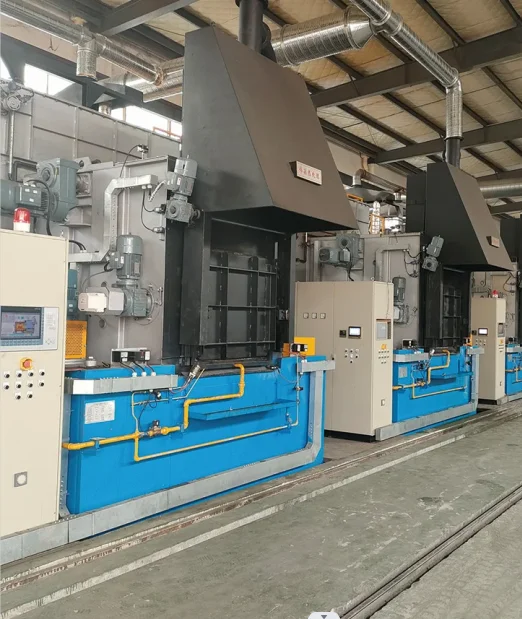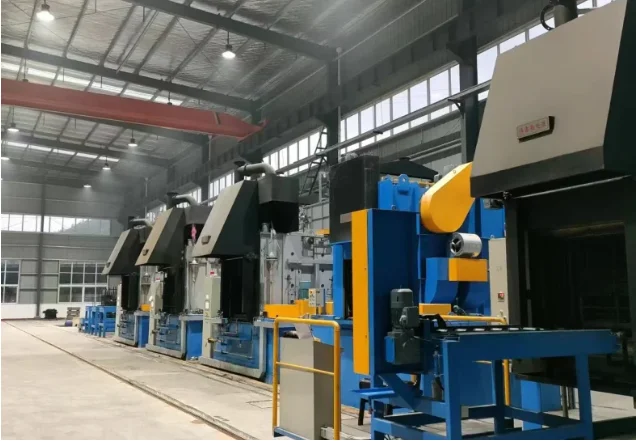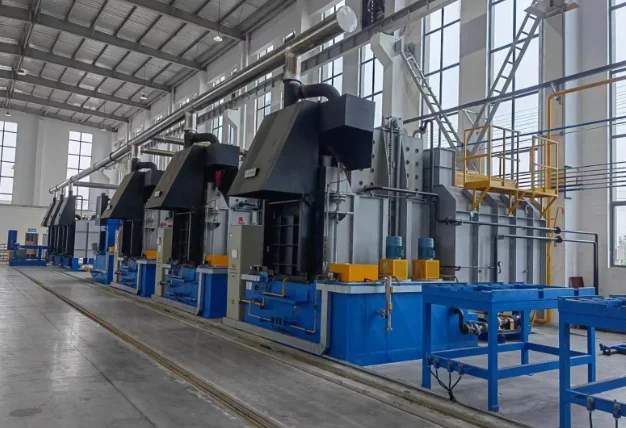Tempering furnaces play a crucial role in the heat treatment process, ensuring the desired mechanical properties of metal components. These specialized furnaces use controlled heating and cooling to enhance the strength and durability of materials. Understanding the significance of tempering furnaces is essential for industries requiring precise control over metal properties to meet stringent quality standards.
Understanding Tempering Basics
Definition of Tempering
Tempering in metalworking refers to the process of heating a material, such as steel, to a specific temperature and then cooling it in a controlled manner. This technique is used to adjust the hardness and toughness of the metal.
Importance of Strength and Ductility Balance
Achieving the right balance between strength and ductility is crucial in metalworking. Strength ensures that the material can withstand external forces without deforming, while ductility allows it to deform without breaking under stress. Balancing these properties is essential for creating durable and reliable metal components.
Historical Significance of Tempering
The tempering process has a rich historical importance dating back centuries. Ancient civilizations, such as the Egyptians and Greeks, utilized various forms of heat treatment to enhance the properties of metals for weapons, tools, and other applications. The development of tempering techniques played a pivotal role in advancing metallurgy and shaping human civilization.
Exploring Tempering Furnaces
Function
Tempering furnaces play a crucial role in the heat treatment process by reducing the hardness of metals like iron. They help in achieving the desired balance between hardness and toughness.
Temperature Ranges
In tempering furnaces, specific temperature ranges are utilized for iron-based metals. These typically range from 400 to 700 degrees Celsius, depending on the desired outcome of the tempering process.
Material Brittleness Reduction
After metals undergo quenching in a quench furnace, they can become excessively hard and brittle. Tempering furnaces come into play here, helping to reduce this brittleness by reheating the metal to specific temperatures.
Varieties of Tempering Furnaces
Electric vs. Gas-Fired
Electric Tempering Furnaces: Electric tempering furnaces are known for their efficient and consistent heat distribution. They are ideal for smaller workshops due to their compact size and easy installation process.
Gas-Fired Tempering Furnaces: Gas-fired tempering furnaces offer rapid heating capabilities, making them suitable for large-scale industrial operations. These furnaces are preferred for their cost-effectiveness in high-volume production settings.
Advantages and Disadvantages
Electric Tempering Furnaces:
-
Pros:
-
Precise temperature control ensures uniform heating, reducing the risk of overheating.
-
Energy-efficient operation leads to lower operating costs over time.
-
Gas-Fired Tempering Furnaces:
-
Pros:
-
Quick heating speeds enable faster processing of materials, enhancing overall efficiency.
-
Well-suited for heavy-duty applications requiring high temperatures.
-
When deciding between electric and gas-fired tempering furnaces, it is crucial to consider factors such as the scale of operations, desired heating speed, precision requirements, and long-term cost implications. While electric furnaces excel in accuracy and energy efficiency, gas-fired options prioritize rapid heating rates and cost-effectiveness for larger production volumes. Each type has its strengths and limitations, catering to different needs within the industry.

The Science of Temperature Control
Precise Control
Temperature control is crucial in tempering furnaces to achieve desired metal properties. Uniform temperatures ensure consistent results.
Maintaining precise temperatures during the tempering process is essential for achieving the desired mechanical properties in metals. Inconsistent temperatures can lead to variations in hardness, toughness, and other crucial characteristics.
Mechanisms Used
In tempering furnaces, temperature uniformity is maintained through advanced mechanisms like vacuum technology. This technology helps regulate heat distribution within the furnace.
To ensure that the metal undergoes a controlled transformation, tempering furnaces utilize sophisticated systems that monitor and adjust temperature levels continuously. Vacuum chambers, for instance, aid in creating an environment where temperature fluctuations are minimized.
Consequences of Inadequate Control
Inadequate temperature control can have detrimental effects on the properties of metals being tempered. Uneven heating may result in inconsistent hardness levels across a metal component.
When temperature control is not precise, metals may exhibit undesirable traits such as brittleness or insufficient strength. These issues can compromise the integrity and reliability of the final product.
Heating Methods Uncovered
Ceramic Elements
Ceramic heating elements play a crucial role in uniform heating within tempering furnaces. These elements are known for their high heat capacity and excellent thermal conductivity.
The surface of ceramic heating elements ensures efficient heat transfer to the materials being processed. This results in consistent and precise temperature control during the tempering process.
Electrical Wires
Electrical wires or coils are fundamental components in the heating process of tempering furnaces. These wires generate heat through electrical resistance, contributing to the gradual and controlled increase in temperature.
The source of heat in these furnaces is primarily from the electrical energy converted by the wires or coils. This method allows for quick response times and accurate temperature adjustments based on the requirements of the materials being treated.
Process of Tempering Detailed
Soaking Significance
Soaking materials in a tempering furnace before quenching is crucial. This process ensures uniform temperature distribution throughout the material, preventing internal stresses.
The soaking period allows the material to reach equilibrium with the furnace temperature. This minimizes the risk of cracking or distortion during subsequent cooling.
Temperature Ranges
During tempering, specific temperature ranges are critical for phase transitions. The initial heating phase typically reaches around 500-600°C, ensuring thorough heat penetration.
As the material reaches this temperature range, it undergoes structural changes that improve its toughness and ductility. Subsequent cooling at controlled rates further refines these properties.
Importance of Quenching
Quenching involves rapidly cooling the material after tempering to achieve desired hardness levels. The rapid cooling helps lock in the structural changes induced during tempering.
A carefully controlled quenching process is vital to prevent excessive hardness or brittleness, striking a balance between strength and flexibility.

Industrial Applications of Tempering
Diverse Sectors
Various industrial sectors rely on tempering furnaces to enhance the properties of their products. The automotive industry utilizes these furnaces to strengthen components like engine crankshafts and transmission gears. The aerospace sector employs tempering for critical parts such as landing gear components and turbine blades.
Specific Products
Products across industries undergo tempering to achieve specific characteristics. In the construction sector, tempered glass is widely used for its increased strength and safety features. In the manufacturing of cutting tools, steel undergoes tempering to improve toughness and durability. Moreover, in the production of springs, tempering is essential to enhance flexibility while maintaining strength.
Economic Impact
The utilization of tempering processes significantly impacts industrial production economically. By enhancing the mechanical properties of materials, tempering increases product longevity and reliability. This leads to reduced maintenance costs and downtime for machinery, ultimately improving operational efficiency. Moreover, tempered products often command higher prices due to their superior quality and performance, contributing to increased revenues for manufacturers.
Choosing the Right Tempering Furnace
Capacity Considerations
When selecting a tempering furnace, it's crucial to assess the capacity requirements. Evaluate the size and weight of parts needing tempering to match them with the furnace's internal dimensions. Ensure that the furnace can accommodate your production volume efficiently.
Adequate capacity ensures that all components receive uniform heat treatment, preventing inconsistencies in hardness and durability. Having excess capacity also allows for future scalability without investing in additional equipment prematurely.
Heating Capabilities Analysis
Different furnaces offer varying heating capabilities such as temperature range, heating speed, and uniformity. Consider the specific heat treatment processes required for your materials and products. Opt for a furnace that provides precise temperature control to achieve desired hardness levels consistently.
Look for furnaces with rapid heating rates to reduce cycle times and enhance productivity. Uniform heating distribution is essential to prevent thermal gradients that could impact material properties negatively.
Supplier Reputation Evaluation
Supplier reputation plays a significant role in selecting a tempering furnace. Choose suppliers with a proven track record of delivering high-quality equipment and reliable customer support. Research supplier reviews, certifications, and industry reputation to ensure credibility and trustworthiness.
Reliable suppliers offer comprehensive technical assistance, maintenance services, and spare parts availability. Establishing a strong partnership with reputable suppliers ensures long-term support for troubleshooting, upgrades, and continuous improvement initiatives.
Maintenance and Safety Tips
Best Practices
Regular maintenance is crucial for the efficient operation and longevity of tempering furnaces. Firstly, ensure that the furnace's work zone is kept clean and free from debris to prevent any interference with the heating elements. Secondly, routinely check and replace worn-out parts such as heating elements or thermocouples to maintain optimal performance. Lastly, schedule periodic inspections by qualified technicians to identify and address any potential issues promptly.
Safety Protocols
When operating tempering furnaces, prioritize safety to prevent accidents and injuries. Always wear appropriate personal protective equipment (PPE) such as heat-resistant gloves and safety glasses to shield against heat and potential hazards. Establish clear protocols for handling hot materials and ensure proper ventilation in the workspace to minimize exposure to fumes. Regularly train all users on safe operating procedures to mitigate risks effectively.
Importance of Inspections and Calibration
Regular inspections and calibration are essential for ensuring the accuracy and reliability of tempering furnaces. Conduct thorough inspections at specified intervals to detect any signs of wear, damage, or malfunction that may impact performance. Calibrate temperature settings, timers, and other controls as needed to maintain consistent results during the tempering cycle. By adhering to a strict maintenance schedule that includes inspections and calibration, you can optimize furnace strength and prolong its lifespan.

Closing Thoughts
In conclusion, the exploration of tempering furnaces has shed light on the crucial role they play in various industries. Understanding the basics, types, operational processes, and maintenance tips is vital for ensuring efficient and safe operations. The intricate science behind temperature control and heating methods underscores the precision required in tempering processes.
To delve deeper into this subject, further research on emerging technologies in tempering furnaces and their impact on industrial applications is recommended. By staying updated on advancements in this field, one can enhance operational efficiency and product quality. Continuous learning and adaptation to new trends will be key in maximizing the benefits of tempering furnaces.
Frequently Asked Questions
What are the key components of a tempering furnace?
A tempering furnace typically consists of heating elements, temperature control systems, quench tanks, conveyor belts, and cooling chambers to ensure precise heat treatment processes.
How does tempering differ from other heat treatment methods?
Tempering involves reheating hardened steel to a specific temperature and then cooling it gradually to enhance toughness and reduce brittleness, unlike hardening or annealing processes that focus on different material properties.
What safety measures should be followed when operating a tempering furnace?
Operators must wear appropriate personal protective equipment (PPE), regularly inspect equipment for any signs of wear or damage, ensure proper ventilation in the workspace, and strictly adhere to established operating procedures to prevent accidents and injuries.
Can different materials be tempered using the same type of tempering furnace?
Yes, tempering furnaces can accommodate various materials such as steel, aluminum, and glass by adjusting temperature settings and processing parameters according to the specific requirements of each material's composition and desired outcome.
How often should maintenance checks be conducted on a tempering furnace?
Regular maintenance checks should be scheduled at least quarterly to inspect heating elements, thermocouples, insulation, seals, and overall system performance. Timely maintenance helps prevent breakdowns, ensures consistent quality output, and prolongs the lifespan of the tempering furnace.

